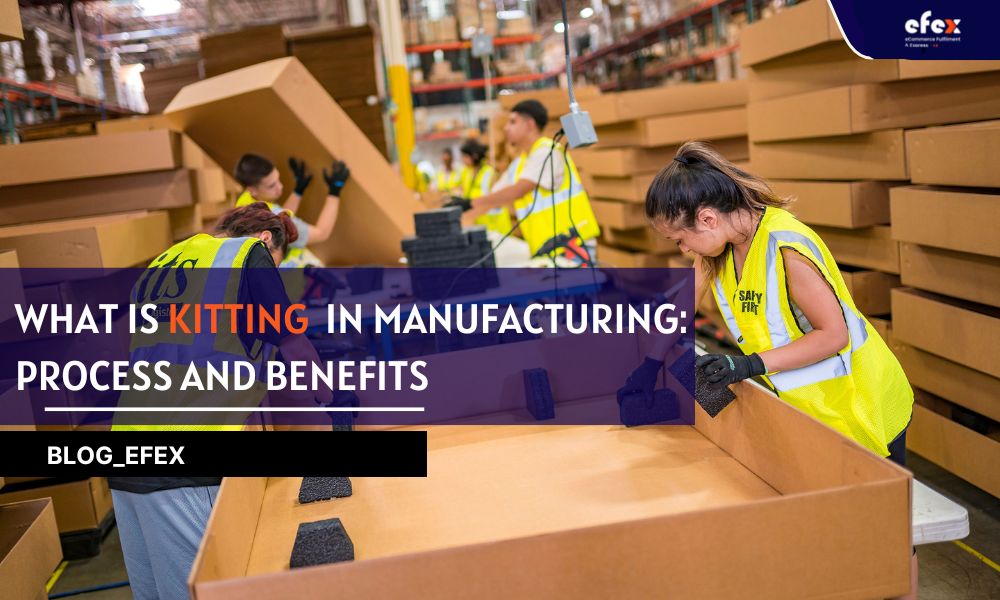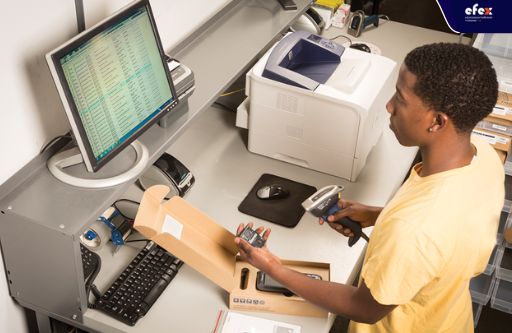
More Helpful Content
Kitting is a common inventory management method for reducing the difficulty and enhancing the productivity of assembly in a production process. This method is especially beneficial in assemblies when a large number of small parts are required to finish a specific piece of the product and is required for make-to-order items that are highly tailored for the final consumer.
In this article, we'll look at how to define kitting in manufacturing, how the kitting in the manufacturing process is employed, as well as the several advantages it can give to a business.

Kitting is the process of choosing and distributing all of the essential components for the assembly of a certain product. Kitting can also take place within a manufacturing plant, in a cell separate from the main assembly line, or by a manufacturing company's third-party partner companies.
Manufacturing kitting is especially advised when a manufacturer needs a large number of tiny parts to complete a product. In some cases, the procedure is ideal for factories with little floor space for storing required parts. Moreover, kitting is also useful when a production company creates customized items for its consumers.
Kitting, for example, is useful for developing unique products which require parts or components that are of various colors or have varied specs. In other cases, workers might lose a significant amount of time scouring the facility for all the screws or sub-parts required to complete an appliance. As a result, the essential parts are ready in their appropriate bundles, available for use on the assembly line.
👉 Read More: What Does A Backorder Mean: Managing Tips and Solutions
👉 Read More: What is SKU Number? Example and Benefits
Material kitting in the production process is unique since it can arise at almost any time. Once items or raw materials are transported to the production plant, kitting will begin. Alternatively, the company can blend these elements with something else created further down the production process. Material kitting is also used at the last assembly phases of complex items, sending extra components developed by the manufacturer to these late places of usage.

Material kits can be created and used at any stage throughout the manufacturing process. Manufacturers' flexibility allows them to support and test a wider range of choices. They can immediately adjust kitting to guarantee a consistent production flow or find solutions to save labor or components usage. Internal kits are frequently packaged for faster usage.
As a result, easier packing is possible, lowering the cost of transporting kits across a manufacturing floor. Employees at the kit's point of use are familiar with what should be included. This uniformity keeps a manufacturing line running smoothly and allows quality and other problems easier to control.
The production setup differs from that of eCommerce, where a product kit is often created at the conclusion of the packing process. They mix the items in a regular box or personalized packaging that advertises the kit's benefits. Decreased expenses, receiving some for free, avoiding running out as fast, obtaining all you need to experience a product, and much more might be included in those sales pitches.
👉 Read More: What Is Stockout Cost? Formula And Example
The manufacturing kitting process has advantages for both the maker and the customer, and it includes both supply and product kits. These can be seen immediately, such as warehouse space requirements, or in an indirect way, that is a reduced per-unit cost due to the manufacturer's increased efficiency.

It's easier to keep a single kit close to a workstation than it is to keep several individual components. The employee can utilize a pre-packaged kit and then transmit the product down the supply chain. Kits will have to be housed on the shelf if the producer is producing them in volume. These shelves may be configured to hold as many kits as feasible, plus their uniformity makes this possible at a reduced cost.
A kit also provides extra space for personnel and assembling equipment, which is a similar but significantly different benefit. Since inventory isn't kept on hand, the staff may build things with less storage space. Internal services that deliver kits remove the need for huge storage units, many drawers, and other items. Increasing space makes it simpler to build a manufacturing line that is as efficient as possible, develop the business, and keep labor and equipment costs under control.
Kitting process in manufacturing is about more than just saving money. It's one of the most prevalent ways for manufacturers to speed up processes. By removing touchpoints, production lines can minimize the number of pauses or points they require, enabling the process to go faster.
As a result, the amount of floor space required per product is reduced, allowing businesses to create more. Bundling parts also allows employees to do multi-step jobs more rapidly.
Bundling can help producers save money on shipping in a variety of ways. Internally, merging goods reduces the number of boxes that must be transported from one area to another. This can cut down on the amount of time it takes to transport these products during the workday.
Because they make fewer pauses and take fewer steps per item, these solutions also create less damage to equipment. Manufacturers can save money on transportation by putting more items into an FTL or LTL shipment from the outside. They may then improve kits and packing for freight deliveries, and start moving more things for the same amount of money. This is a widely used process of income protection.
While most inventory control is handled by software, kits make it easier on the factory floor. Because you've kept things equally, employees can spot-check stock or conduct cycle counts more precisely. A warehouse that uses a combination of technology and logical stacking can better understand its inventory and minimize sales problems caused by stockouts and backorders.
Kitting allows producers to provide a wider selection of products and components, which is one of the most significant advantages. They can sell you one solitary SKU or a single, fresh SKU that includes everything linked to it. As a result, you get to create that known value for your customers, providing them with all of the parts they'll need to experience your best-selling items.
It can even point you in the direction of relevant categories depending on the components and materials you have on hand, as well as your clientele. Identifying manufacturers that are willing to be flexible might help you provide better goods and services to your buyers, particularly if you operate a dropshipping business.
You'll be satisfied with your manufacturer or 3PL kitting if they focus on elements that lead to sales. Customers who are happy, whether they are you or the end-user, are equal to repeat customers. Using the most up-to-date sales software to analyze such patterns, you can identify chances to work with suppliers and provide a kitting monthly subscription to boost sales.
Managing your staff and transportation expenses equals more cash on hand at the end of the day. We have yet to come across a corporation that is opposed to lucrative efficiency.
A company's profit margin is eroded by higher manufacturing expenses. Optimized storage and more efficient production, on the other hand, may go a long way toward lowering manufacturing costs and increasing profit in the manufacturing industry.
👉 Read More: What Is A Stockout: Rate, Formula, And Risk
As previously stated, there are a few unique business scenarios where a kitting procedure as part of the overall assembly may be beneficial. They frequently include assemblies that need a large number of tiny components, and where an operator would benefit from having access to all of the components as they do their job.
Additionally, kitting is advantageous when the completed product requires modification when the end-user needs new components, features, or colors. The following are some examples of items that benefit from kitting throughout the manufacturing process:
Kitting has an influence on inventory management when organizations employ it for any purpose. Fundamentally, they're mixing various elements to create something new. This effectively merges numerous SKUs into a single new one. Item counts for each manufactured item must be updated by inventory management.
While kitting has many advantages for a manufacturing company, it has several drawbacks when done manually. Manual kitting necessitates appropriate staff sorting through several boxes in order to extract specific components needed to complete a product. This method of kit, however, has multiple areas of error because it is a human operation.
As a result, workers on the assembly line may encounter parts that are incompatible. Kitting software, on the other hand, automates the procedure. Kitting software also automates data collecting and aids in the tracking of all goods used in manufacturing, making it crucial for firms who need proof of traceability for regulatory compliance.
- Read More: Order management system for Ecommerce: Definition, Key Effect, Benefit
- Read More: Order Management System: Definition, Process And Value

By automatically updating counts as units are generated, technology makes the whole process much more controllable. This eliminates the need for human data entry, which might cause your kitting or manufacturing process to break down.
Kitting in manufacturing appears to be similar to what your company or Efex Fulfillment can perform on its own. Producers benefit because they may regard segments of their shop floor or manufacturing line as "customers" to whom they can supply kits and save money. Due to the obvious internal usage, the logistics are simpler here, and the benefit is basically free.
They may, for example, give you a lot of comparable options as they master these opportunities. Then, with this or your own kitting, your company may seek ways to increase sales.
During the final assembly of a product, Efex plays a similar role for many firms. Our warehouse professionals can assist your company in growing by mixing the appropriate items into a customized box, ensuring that your customers have a positive experience that showcases your company. Providing this at the facility shortly before we choose, package, and deliver an order allows you to tailor kitting to current client demand.
If you'd like to learn more about what this means for you and how kitting may help your company stand out, reach out to our Pick And Pack Order Fulfillment Service today!


